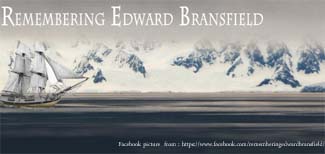
Edward Bransfield (1785-1852): Forgotten Irish Antarctic Explorer
He was born in the small village of Ballinacurra, near Midleton, Co. Cork. At a young age while on a fishing boat with his father he was press-ganged into the British navy, in need of reinforcements, by the frigate Dryad in 1803. He was brought to the Plymouth naval base from which he served for eleven years on various warships, not seeing Cork again until 1814. His remarkable aptitude as a seaman was noted and he was promoted to quartermaster and then, exceptionally for a man of his background, received from Trinity House, London, his certificate as master, with competence to act as navigator of ships of any kind.
After the Napoleonic Wars (1800-15) in which he served in the Atlantic and Mediterranean, he was chosen before many masters with greater seniority to accompany a naval expedition to Chile. There he was given command of a merchant ship and instructed to sail south and explore. He discovered and meticulously charted the South Shetland Islands and, late in 1819, became the first person ever to see the Antarctic Continent. Bransfield Island, Bransfield Strait, Bransfield Trough, Bransfield Rocks and Mount Bransfield were all named in his honour. On his retirement from the navy he commanded ships in European waters.
The ‘Remembering Edward Bransfield Committee’ was formed in 2016 comprising historians and others to bring the story of the maritime explorer’s exploits and pioneering achievements to the fore. With the support of several local and multiple partners at home and abroad including wide coverage by local associations with lectures and talks, press coverage and the wider media including research of historical and naval records, it succeeded in a fundraising campaign, public and private, to honour the seaman by erecting a dedicated monument in his home place in Co. Cork. It marks the 200th anniversary of when he led the first exploratory voyage to discover the Antarctic mainland.
In 1999 his grave, discovered in a deteriorated state in a Brighton graveyard in the United Kingdom was renovated, funded by charitable donations, by Shiela Bransfield. In 2002 she completed a Masters’ thesis on his role in the discovery of Antarctica at the Greenwich Maritime Institute. The event was marked by a ceremony attended by numerous dignitaries. In 2000 the Royal Mail issued a commemorative stamp in his honour. Since no likeness of him could be found the stamp depicted instead RRS Bransfield, an Antarctic surveying vessel that was named after him.
Unveiling of Monument
On 25 January 2020 on a cold and damp day, several hundreds of people gathered at the birthplace of Ballinacurra’s native son to witness the event in his honour after a lengthy and distinguished maritime career. A descendant of Bransfield’s brother William, Elisa Gallo from Boston, was present to unveil the monument along with many local and other dignitaries including the monument’s sculptor, Matthew Thompson.
Made from a block of Ballinacurra limestone, the memorial is inspired by the shape of navigation markers or beacons built by sailors and fishermen to mark the entrance to safe harbours such as the one in Baltimore, West Cork. Set into the limestone are other names of Ireland’s great polar explorers who followed in his wake. Among those recorded are Francis Crozier, Ernest Shackleton, Tom Crean, fellow Corkmen Robert Forde from Bandon, Patrick Keohane from Courtmacsherry, and brothers Tim and Mortimer McCarthy from Kinsale.
Chief of Staff of the Defence Forces, Vice-Admiral Mark Mellett, recalled how Bransfield was press-ganged into the Royal Navy before proving himself an expert navigator and rising though he ranks. He noted how, after fighting with the Royal Navy in the Napoleonic Wars, he was sent to Valparaiso in Chile, in 1817. Two years later he embarked from there to the discovery of Antarctica. He described Bransfield as ‘an extraordinary man’ and paid tribute to the Remembering Edward Bransfield Committee for their campaigning and fundraising to erect a monument to him … it was important to recognise Ireland’s rich polar heritage and paid tribute to the Committee for its tenacity in working to have a monument for Bransfield to be recognised in his own village.
Its inscription reads: Brig Williams EDWARD BRANSFIELD 1785-1852 Ships Master and ANTARCTIC EXPLORER from Ballincurra, Co. Cork, Leader of the first expedition to see and chart the Antarctic Mainland on the 30th of January 1820. The monument is carved with a sexton at the top and a penguin at the bottom, in his memory.
He is buried alongside his wife in the cemetery in Brighton. To coincide with the 200th anniversary, on 30 January 2020 a blue plaque will be placed on his home in the coastal town of Brighton, England.
- Ita Marguet
- January 2020
Note: Acknowledgement is given to sources used in preparation of this text. It follows texts written in 2007 entitled Story of Antarctica: Explorers Scott and Shackleton and Thomas Crean: Irish Antarctic Explorer, by Ita Marguet.





